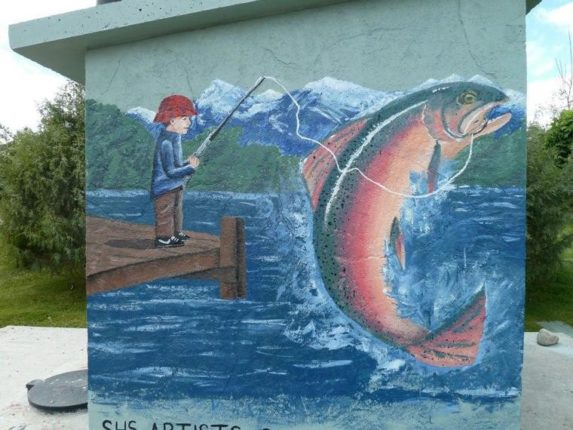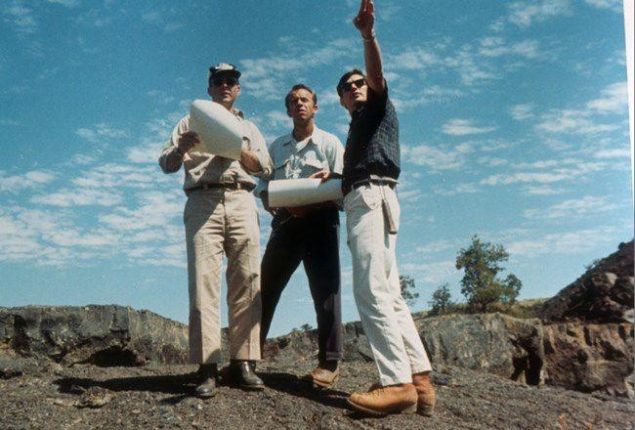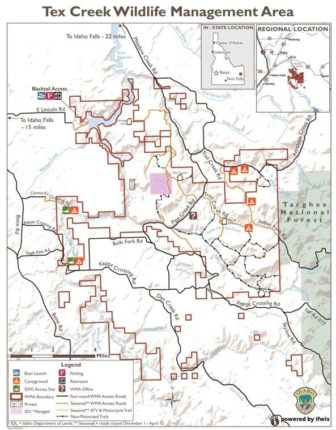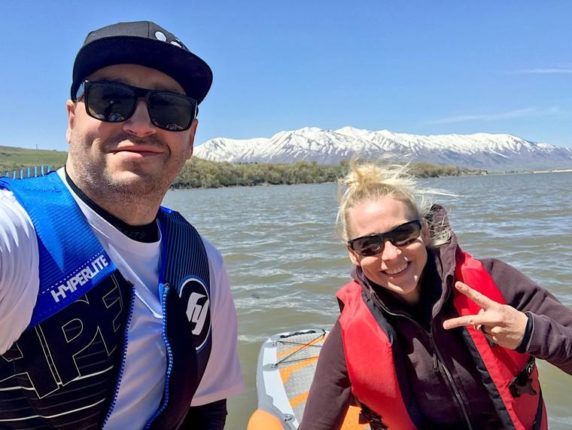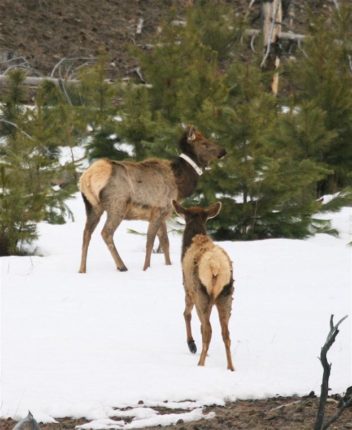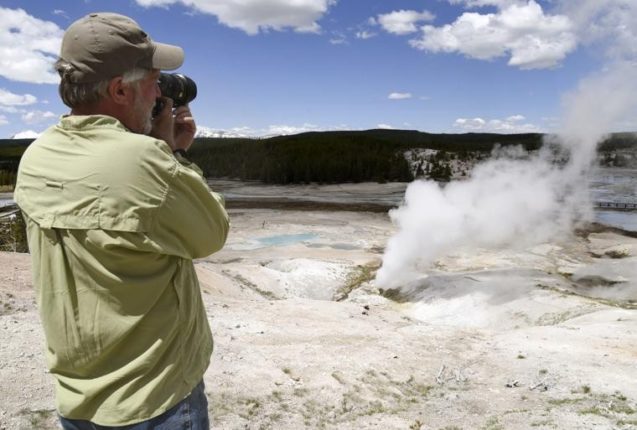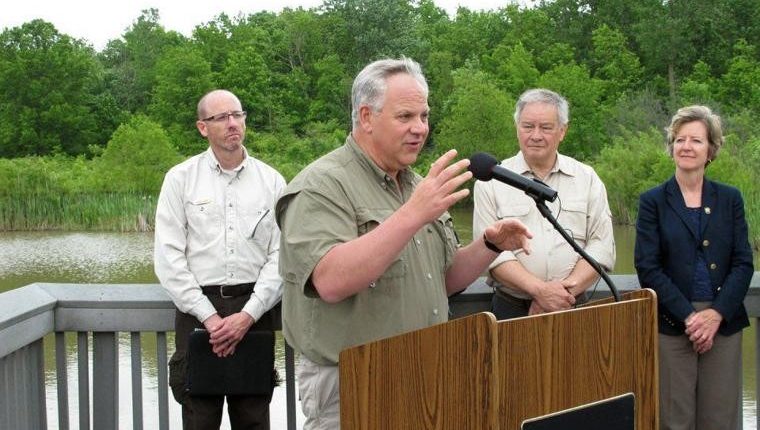Privy, latrine, commode — there are many names for an outhouse.
These small, yet convenient outdoor restrooms have been answering desperate calls of nature for years at boating and fishing access areas across the state. But along the Salmon River between Challis and North Fork, seven of these plain-looking structures have been transformed into works of art.
Several local artists and high school art students have volunteered their talents to paint colorful murals inside and outside, transforming them into something the nearby communities can be proud of and visitors appreciate.
“The results are original works of art that receive far less abuse and require less maintenance over the long term,” said Caryll McConnell, an Idaho Fish and Game employee who spearheads the effort. “It’s been rewarding and fun, a win-win approach for everyone.”
McConnell, a self-described “hobby artist” who majored in art in college, also works seasonally for Fish and Game to maintain boating and fishing access sites in the Salmon-Challis area. She and others thought combining art with community involvement as a creative approach to reduce vandalism, maintain cleanliness and instill community pride in these sites.
“The idea is simple,” she said. “Utilize local people and their talents to promote a sense of pride and ownership in these facilities, and so far it’s been working nicely.”
According to McConnell, very minor vandalism has occurred at a few sites, but not nearly as much as in the past.
Kid’s Creek Pond in Salmon was the first roadside bathroom to receive an artistic makeover in 2012. This popular area is owned by the city of Salmon and co-managed by Idaho Fish and Game, which regularly stocks rainbow trout and excess hatchery steelhead and salmon for anglers. The area is also utilized by local educators as an outdoor classroom.
After receiving complaints that the restroom building was unsightly and just didn’t match such a nice area, McConnell pitched her community art idea to a friend, Meri Galvan, a Salmon High School art educator. It turned out both the art concept and location were perfect.
After practice painting native fish in the classroom, Galvan and 14 of her students painted an underwater mural on the interior and a colorful fishing scene on the exterior. The fish displayed reflect the personalities of the many artists in true collaboration. Their work is also signed and personalized so everyone knows this was a community project and completely original.
“It was exciting to watch the artwork develop and everyone thoroughly enjoyed the creative process,” McConnell said.
Twenty miles south of Salmon on Highway 93, an eye-catching bull elk and wildflowers decorate the exterior walls of a small restroom at the Elk Bend boating access site, as vivid Sockeye and Chinook salmon, steelhead and sturgeon enhance the interior. Artists of the Lemhi Art Guild of Salmon transformed this once drab building into a bright, attractive bathroom in 2014.
“The artists literally put the elk in Elk Bend and salmon along the Salmon River,” McConnell said with a smile.
Artwork at the Colston access site, located 12 miles south of Elk Bend, was made possible by the Challis Arts Council. Three youth and four adult artists, under the guidance of artist Sahra Beauprè, designed and painted a colorful mural, depicting the surrounding Salmon River country. Six shaded campsites along the river and a natural boat ramp make this a very popular year-round destination.
Summer boaters, picnickers and steelhead anglers will enjoy a Salmon River sunrise over the nearby Bitterroot Mountains at the Carmen Bridge access site, located four miles north of Salmon. Six students from the Upper Carmen Charter High School captured this nearby scene in 2018, one week before commencement.
“This marked the last year the school was in operation, so it was a fitting tribute to a great little school,” McConnell said.
Bathrooms at the Lemhi Hole, Bobcat Gulch and Red Rock access sites have also been transformed by local artists Cheryl Detwiler-Mihalka, Lynn Federspiel-Young, Heidi Messner, Nancy Russell, as well as McConnell. Native fish and wildlife commonly observed in the area adorn the interior walls at each site.
“At Bobcat Gulch, we decided to exhibit creatures you really don’t want in camp,” said McConnell, referring to the skunk, mountain lion, rattlesnake, raccoons and black bear family. “But they’re actually quite beautiful to see, especially in paint.”
At Red Rock, one of the busiest access sites along the river, the artists used a creative method known as Zentangle to exhibit local river wildlife. This modern approach uses bright colors within shapes in repetitive patterns. A bighorn ram, osprey, otter, kingfisher, crane, heron and various native fish now provide visitors an appealing view rather than featureless interior walls.
“Creativity is contagious,” McConnell said. “And we’re working on it — one beautiful outhouse at a time.”
Funding to purchase and maintain Idaho’s 300-plus boating and fishing access sites managed by Fish and Game comes from the purchases of hunting and fishing licenses, tags and permits, along with an excise tax on hunting and fishing equipment.
A single-page brochure with Highway 93 milepost location, artist’s names and photographs of each site is available at the Fish and Game office in Salmon. Another useful guide is the Salmon Region Access Guide, which highlights most sites from the Stanley Basin to Corn Creek, as well as sites along the Lemhi River. This guide is also available in print at the Salmon Fish and Game office.

